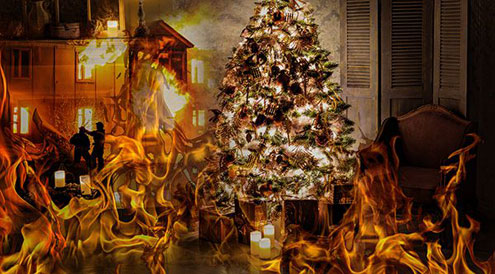AgriLife Extension specialist has tips
on Christmas tree fire safety, collection
COLLEGE STATION – Taking proper care of and precautions with Christmas trees can keep them from catching fire until they can be properly disposed of, said a Texas A&M AgriLife Extension Service specialist in family and community health.
“While Christmas tree fires are fairly rare, they can still cause serious property damage and possibly injury or death,” said Joyce Cavanagh, College Station. “The fires typically start due to an open flame from a candle or a short in the electrical lights, but there are other ways Christmas trees can catch fire.”
She said it is important to properly maintain Christmas trees and take steps to help ensure they do not catch fire. She and the National Fire Protection Agency offered the following tips for Christmas tree safety:
— Provide a direct water source for your tree or water it frequently to keep it from drying out.
— Inspect holiday lights for frayed wires or wear that might spark a fire.
— Never use candles as tree decorations and buy electrical lights that meet independent laboratory testing standards and are labeled flame-retardant.
— Keep the tree 3 feet or more away from any heat source such as a fireplace, stove, radiator or candle.
— Make sure the tree is not blocking an exit in the event there’s a need to escape.
— Turn off the tree lights when going to bed or away from home.
— Remove the tree from the home when needles start dropping and turning brown.

Cavanagh said even though a Christmas tree has been removed from a home, it may still present a fire hazard.
“Dried-out trees constitute a real fire danger and should not be left in the garage or placed outside next to the exterior walls of your home,” she said. “See if your community has a Christmas tree collection or recycling program, make arrangements for pickup from the appropriate removal service as soon as possible.”
Cavanagh said for proper and safe disposal of Christmas trees, all ornaments, tinsel, ribbon, lights and other non-organic materials should be removed.
“If needles drop onto the floor during the process of tree removal, it’s better to sweep them up as opposed to vacuuming, because the needles can clog your vacuum cleaner,” she said.
Cavanagh also said large Christmas tree disposal bags are an excellent way to cut down on the mess and are available at many home improvement stores.
“Most communities have curbside Christmas tree collection for a few weeks after Christmas and some offer it throughout the month of January,” she said. “And many communities also have free tree drop-off locations. Some debris removal services may require trees to be cut into 4-foot or shorter lengths, so it may be necessary to cut the tree in half.”
Should the designated Christmas tree collection time be missed, Cavanagh said unflocked trees can usually be chopped up and put into the organic or yard waste container for collection during the next regularly scheduled pickup.
“Flocked trees will likely need to be chopped up and disposed of along with your regular solid waste,” she said.
Cavanagh also noted tree recycling and mulching programs are gaining popularity in many communities.
“You can check with your local department of public works for information on whether this service is available in your area,” she said. “For these programs, they chip and shred the trees, then make the mulch available for use in your garden. Your hauler can usually notify you of pickup dates in your area and what you need to do to get your tree ready for recycling.”